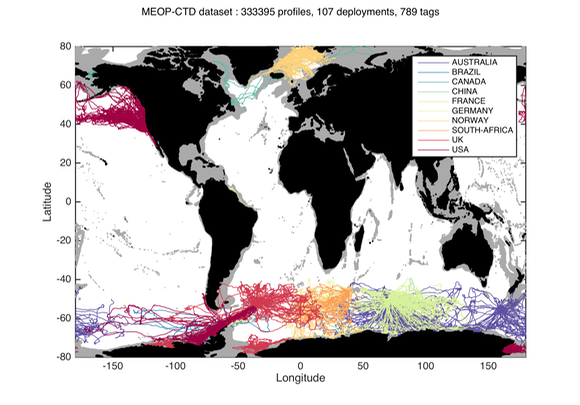Marine turtles, birds, mammals
Type of resources
Available actions
Topics
Keywords
Contact for the resource
Provided by
Years
Formats
Representation types
Update frequencies
status
Scale
-

Tracking data of 7 grey seals were obtained from the deployment of Fastloc GPS/GSM tags developed by the Sea Mammal Research Unit (UK). Full tag description is available at: http://www.smru.st-andrews.ac.uk/Instrumentation/GPSPhoneTag/. The tags include a wet-dry sensor from which haulout events are recorded, a pressure sensor providing detailed dive data, as well as a Fastloc GPS recording irregular locations when the seal is not underwater. Data is stored onboard and transmitted via the GSM network when the seal is in the reception range. The data provided here are the individual GPS locations of the seals fitted with these tags for an average duration of 135 days.
-

Cetaceans adjust their distribution and abundance to encountered conditions across years and seasons, but we poorly understand such small-scale changes for many species, especially in winter. Crucial challenges yet weight on some populations during this season, such as the high levels of fisheries-induced mortality faced by the common dolphin (Delphinus delphis) in the North-East Atlantic shelves. For such species, comprehend the winter fine-scale dynamics is crucial. We aimed at identifying the dolphin distribution drivers within the winters 2020 and 2021, with a focus on determining the lag between changes in oceanographic conditions and in dolphin distribution. They were related with temporal delays specific to the nature and the cascading effects oceanographic processes had on the trophic chain. By determining the most important conditions and lags to dolphin distributions, we shed light on the yet poorly understood intrusions of dolphins within coastal waters during winter: they displayed a strong preference for the coastal-shelf waters front and extensively followed its spatial variations, their overall densities increasing over the period and peaking in March-April. The results presented here provided invaluable information on the winter distribution dynamics and should inform management decisions to help reducing the unsustainable mortalities of this species in fisheries by-catch.
-

The willingness to pay (WTP) of people to protect animal populations can be used as a tool for these populations’ conservation. The WTP reflects the non-use value of animals, which can be significant for charismatic species. This value can be used as an economic criterion for decision-makers in order to recommend protective measures. The definition of the WTP to protect a species is challenging, as valuation methods are time-consuming and expensive. To overcome these limitations, we built a benefit transfer function based on 112 valuation studies and apply it to 440 Mediterranean marine species. We extracted these species from the IUCN database and retrieved some required parameters from, amongst others, the FishBase database. Marine mammals appear to have the highest WTP value followed in order by sea turtles, sharks and rays, and ray-finned fishes. Commercial fish species appear to have the highest values amongst the fish class.
-

Since 2004, several hundred seals have been equipped with conductivity-temperature-depth (CTD) sensors in the Southern Ocean for both biological and physical oceanographic studies. A calibrated collection of seal-derived hydrographic data is now available from Coriolis, currently consisting of more than 300,000 temperature/salinity profiles. Delayed mode data, December 2014 https://doi.org/10.12770/0a82d60c-683d-47b8-8bd1-24933ec24983 on the Coriolis ftp server, in /ifremer/marine_mammals/. In a near future (summer 2015), seal data will be updated daily, and a monthly snapshot of the full database will be produced. through the Coriolis data selection tool (Sea mammal or Animal profiles).
 Catalogue PIGMA
Catalogue PIGMA